Physical Address
304 North Cardinal St.
Dorchester Center, MA 02124
Oropharyngeal reconstruction is complex, but an organized systematic approach using the reconstructive ladder aids the surgeon in the decision-making process. The simplest reconstruction that results in the highest level of function should be chosen.
The size and location of the oropharyngeal defect combined with patient-related factors such as age and comorbid status determine the reconstructive technique that is appropriate for each patient.
Limited oropharyngeal defects that do not communicate with the neck often heal well by secondary intention with excellent functional results.
Extensive defects of the oropharynx are best reconstructed with a free tissue transfer. The radial forearm flap or anterolateral thigh flap are the flaps of choice for these defects.
Oropharyngeal defects that involve 50% or more of the soft palate will result in velopharyngeal insufficiency. The reconstruction should address this by narrowing the caliber of the velopharyngeal aperture.
Total glossectomy defects in the context of laryngeal preservation are challenging reconstructions because of risk of aspiration, increased swallowing transit time, and poor speech outcomes. These challenges can be partially addressed by overcorrection of the vertical height of the reconstruction to allow contact with the palate, laryngeal suspension, and sensory reinnervation of the reconstruction when possible.
The complexity of the human upper aerodigestive tract renders oropharyngeal reconstruction one of the most challenging tasks in the field of head and neck surgery. Successful reconstruction requires detailed knowledge of the normal anatomic and physiologic mechanisms of swallowing and velopharyngeal competence, combined with the surgical expertise and insight to execute various techniques for a multitude of defects. The prognosis for oropharyngeal cancer is improving due to the increasing proportion of these cancers that are associated with HPV. These tumors are more treatment responsive and occur in younger patients with fewer comorbidities. The increased survival makes posttreatment function a critical consideration, as a high proportion of these patients will survive their disease. This chapter discusses the various options for reconstruction of oropharyngeal defects and the decision-making process the surgeon must go through when encountering specific defects in this area.
Oropharyngeal reconstruction has gone through several stages in the past 40 years. Reconstruction of this area before the advent of the pectoralis major flap proved difficult and was commonly complicated by wound infection and breakdown. First described in 1979 by Ariyan and Baek and colleagues, the pectoralis major myocutaneous flap revolutionized head and neck reconstruction at that time and added a new dimension to our reconstructive capability. This was soon followed by the introduction of free tissue transfer, which was accompanied by the belief that functionally and esthetically superior reconstructions could now be performed. The effectiveness of these reconstructions is even more important as the prognosis for advanced oropharyngeal cancer has improved.
Several factors influence reconstructive decision making ( Fig. 98.1 ). First, the surgeon must consider the overall medical condition of the patient with particular emphasis on comorbidities that may adversely affect postoperative wound healing, such as peripheral vascular disease, diabetes, previous radiotherapy, and nutritional insufficiency. In addition, the medical history should help determine the patient's ability to tolerate extensive surgery. Severe coronary artery disease, chronic obstructive pulmonary disease, or poor overall functional status or prognosis may preclude a complicated time-consuming reconstruction. Instead, a reliable and more expedient reconstructive technique should be considered. The reconstructive surgeon should also have a detailed preoperative discussion with the patient to determine which donor site would be most appropriate, given the patient's lifestyle and expectations.
Careful three-dimensional analysis of the defect is critical at the conclusion of the ablative portion of the case. The size of the primary tumor, specifically the tumor (T) stage, has been shown to directly correlate with the functional status of the patient in the postoperative period. The soft tissue and the bony defect should be determined. The purpose of the soft-tissue reconstruction is to reestablish bulk, sensation, and a reepithelialized passageway for respiration and deglutition. The dimensions of the defect should be measured with a ruler, or a template of the defect can be fabricated with Esmarch (Microtek Medical, The Netherlands). The subsites of the oropharynx involved should be determined.
Although this chapter focuses on oropharyngeal reconstruction, these defects do not exist in isolation. Factors such as laryngeal and mandibular arch preservation must be taken into account before determining the reconstruction of choice. Also, surgeon and hospital factors come into play in the decision-making process. A surgeon will decide on a reconstructive technique on the basis of his or her experience and level of training. Hospital factors include the availability of an intensive care unit with personnel experienced in monitoring head and neck patients with free flaps, availability of microsurgical instrumentation, and appropriate paramedical staff for rehabilitation.
The associated cost of reconstruction has also become a factor in recent times. Managed care affects most American centers, and cost-containing methods of reconstruction are often stressed in other health care systems. Early studies comparing the cost of free tissue transfer in oropharyngeal reconstruction with pedicled pectoralis major flaps suggested that the overall costs for free flap reconstructions are similar or lower compared with the pectoralis major flap. More recent studies, however, have demonstrated that many thinner, more pliable regional flaps have similar functional outcomes and a lower cost than free tissue transfer for oropharyngeal reconstruction. In areas where universal health care systems are in place, operative time and long waiting lists may dictate which form of reconstruction is used. All things being equal, however, the most important determining factor should be the resultant quality of life for the patient. The method of reconstruction chosen must give the patient the best chance of reestablishing an oral diet, intelligible speech, and a stable airway without the need for a tracheostomy. Quality of life and functional status can be restored at 6 months after reconstruction even for advanced (T3/T4) oropharyngeal cancers, and most have improved posttreatment scores at 1 year.
Various reconstructive options are available for defects of the oropharynx. It is helpful for the surgeon to consider the reconstructive ladder and to work through the possible techniques for a given defect (e.g., soft palate versus base of tongue), starting with the simplest options and progressing to the more complicated ones ( Fig. 98.2 ). The simplest method of reconstruction that achieves the highest level of function should be chosen.
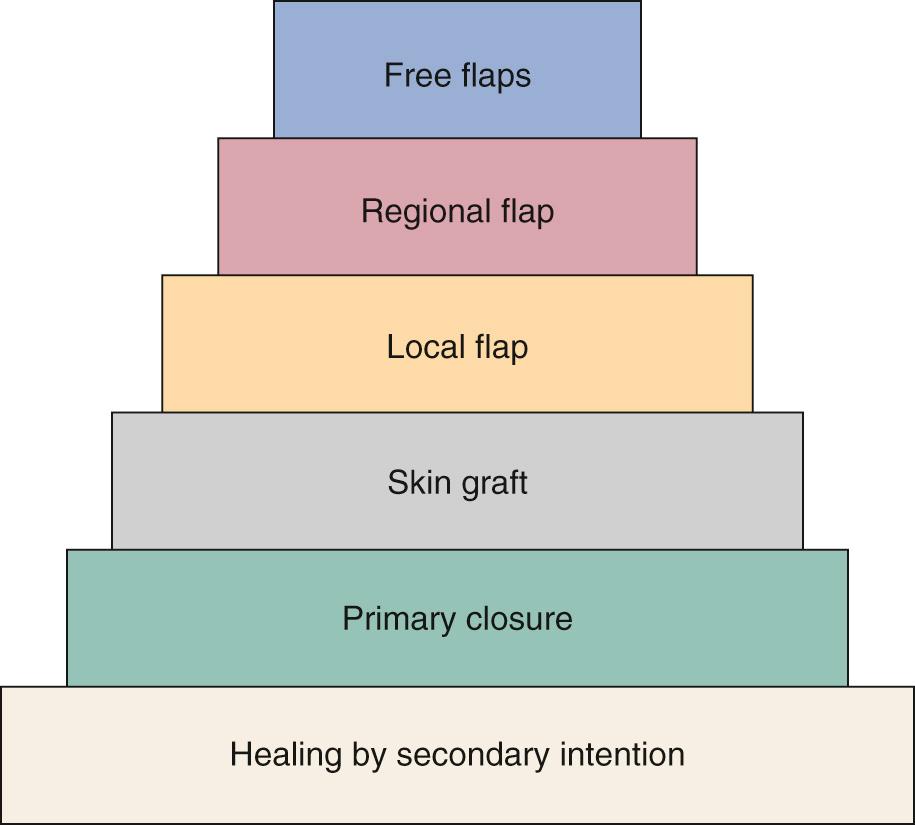
No reconstruction by tissue graft or transfer—that is, healing by secondary intention—is the simplest form of reconstruction. This is not commonly used for open approaches, given the size and complexity of most oropharyngeal defects; however, we have used this as our method of choice after transoral resections of the tonsil, base of tongue, and smaller soft palate defects. It is extremely successful even for deep resections that extend into the parapharyngeal space. Further discussion of the principles of oropharyngeal reconstruction after transoral resections is addressed at end of this chapter. Healing by secondary intention can be used for defects typically less than 5 to 6 cm, although it is not advisable when the oropharyngeal wound communicates with the neck. The main advantage of this method is in its simplicity and in the tendency of the granulating bed to mimic the native tissue when fully healed. An additional advantage is the increased ease of oncologic surveillance because the deep margin of the resection has not been buried by either primary closure or a flap reconstruction. The main disadvantages are the contracture and tethering that can occur when unopposed surfaces heal. This can be a problem particularly for larger resections of the tonsil that are taken into the retromolar trigone, mainly because of the potential for contracture to cause trismus. Healing by secondary intention can also be supplemented by the use of a prosthesis for obturating defects of the palate.
Primary closure is sometimes possible after surgical ablation of an oropharyngeal tumor. It should only be considered when a tension-free closure is obtained without significant distortion of the normal anatomy of the region. A prospective case-comparison study by McConnel and colleagues challenged the idea of free and pedicled flap reconstruction of the oral cavity and base of tongue. They concluded that speech and swallowing are superior with primary closure for defects of 60% or less of the tongue base. Although the defects addressed were small, their findings brought to light the need for objective research on efforts to reconstruct the oropharynx and the effect of reconstruction on speech and swallowing. In the absence of communication of a defect to the neck, primary closure offers few benefits over secondary intention and has several potential drawbacks. The benefits are decreased pain in the immediate postoperative period and potentially less chance of secondary bleeds. The drawbacks include causing maximal contracture of the wound as the wound edges are approximated together. Furthermore, primary closure buries the deep margin, making surveillance more difficult. For these reasons, we now rarely utilize primary closure for the reconstruction of lateral pharyngeal wall or base of tongue defects.
Given the effectiveness of healing by secondary intention, skin grafts are now rarely used for oropharyngeal reconstruction. When utilized, they require a bolster dressing, and a tracheotomy is often required for airway protection.
An alternative to the use of split-thickness skin grafts in the oropharynx is acellular dermis, a bioengineered product formed by the removal of the immunogenic cellular components of dermis. The resulting tissue forms an immunologically inert dermal matrix that can be used as an alternative to skin grafting. Intraoral take rates between acellular dermis and split-thickness skin grafts are similar, and the use of acellular dermis has several potential benefits. These dermal matrices form a scaffold that allows for mucosal epithelialization rather than the keratinized epidermal coverage provided by skin grafts. Another benefit is the lack of donor-site morbidity. Girod and colleagues compared costs between the two techniques in the oral cavity and demonstrated that split-thickness skin graft reconstructions were estimated to be 3.5 times more costly than similar reconstructions with acellular dermis. This study also recommended using a graft thickness of 0.09 to 0.013 inches when resurfacing defects, based on a higher failure rate seen with thicker grafts. In a series of 14 patients, Sinha and associates used thicker acellular dermis as a patch to successfully reconstruct moderately sized through-and-through pharyngeal defects with 100% graft take. A superiorly based sternocleidomastoid rotational flap was used in 10 of these patients to further bolster the graft and to close dead space in the defect.
Local flaps do not usually provide enough tissue for reconstruction after open procedures; however, their use is increasing as more oropharyngeal tumors are being resected transorally.
The palatal island flap is easily harvested and can be used for oropharyngeal reconstruction. The flap is composed of hard palatal mucoperiosteum and is based on a single greater palatine artery ( Fig. 98.3 ). It is performed by sharply incising the mucoperiosteum of the hard palate approximately 1 cm medial to the maxillary alveolus. A periosteal elevator is then used to elevate the flap, and the base is narrowed accordingly. The hard palate is left to remucosalize. The flap provides 8 to 10 cm 2 of thin but relatively nonpliable tissue.
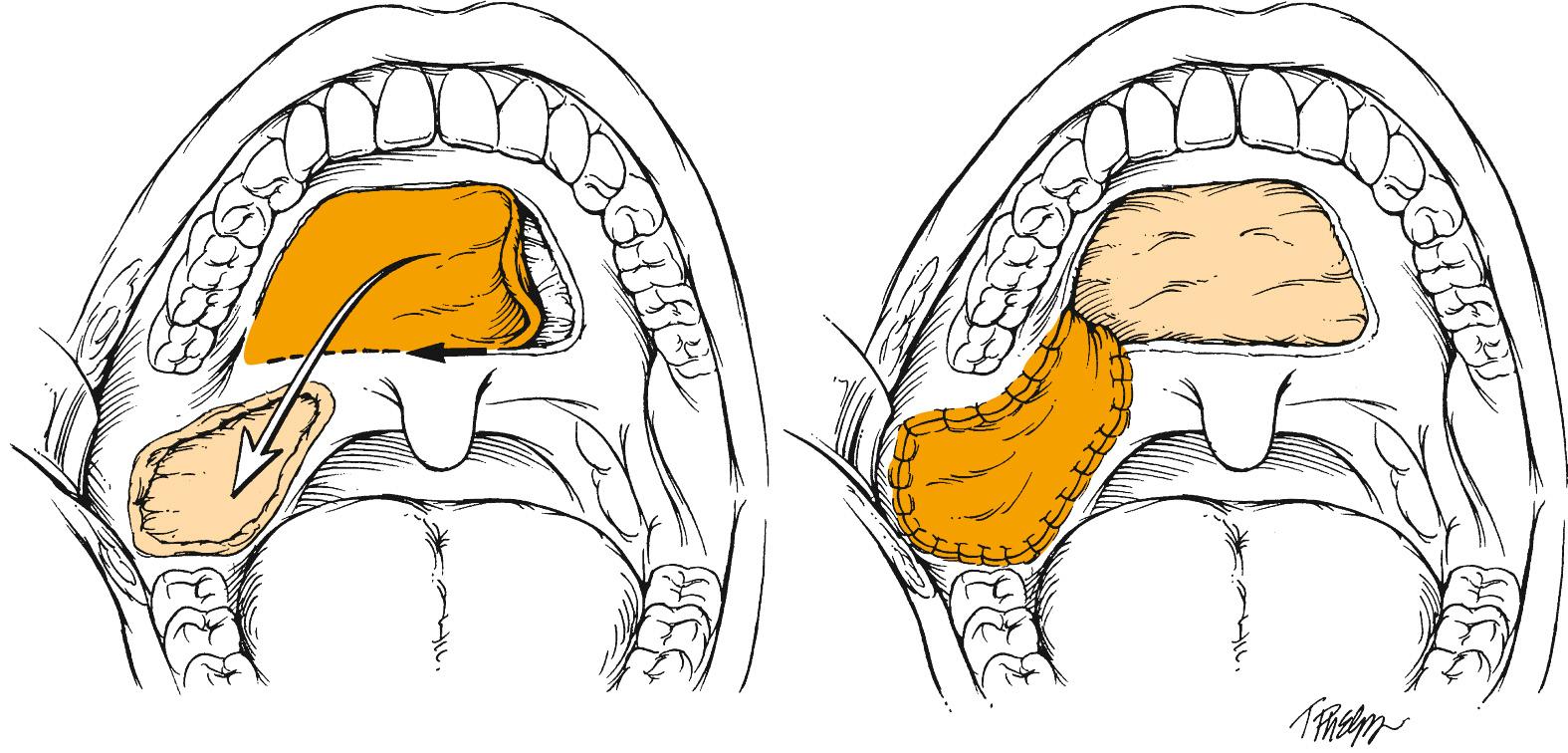
The uvulopalatal flap can be used for limited lateral soft palatal defects. Most of the uvula and the contralateral soft palate must be intact for this flap to be used. The uvula is denuded of its mucosa and is then rotated into the defect ( Fig. 98.4 ). A releasing incision is made in the contralateral anterior and posterior tonsillar pillars to increase the arc of rotation. Other local flaps such as inferior and superior pharyngeal flaps, the superior-constrictor advancement-rotation flap (SCARF), facial artery myomucosal flaps (FAMM), and the buccinator myomucosal flap should also be considered as local flap options for palatal defects.
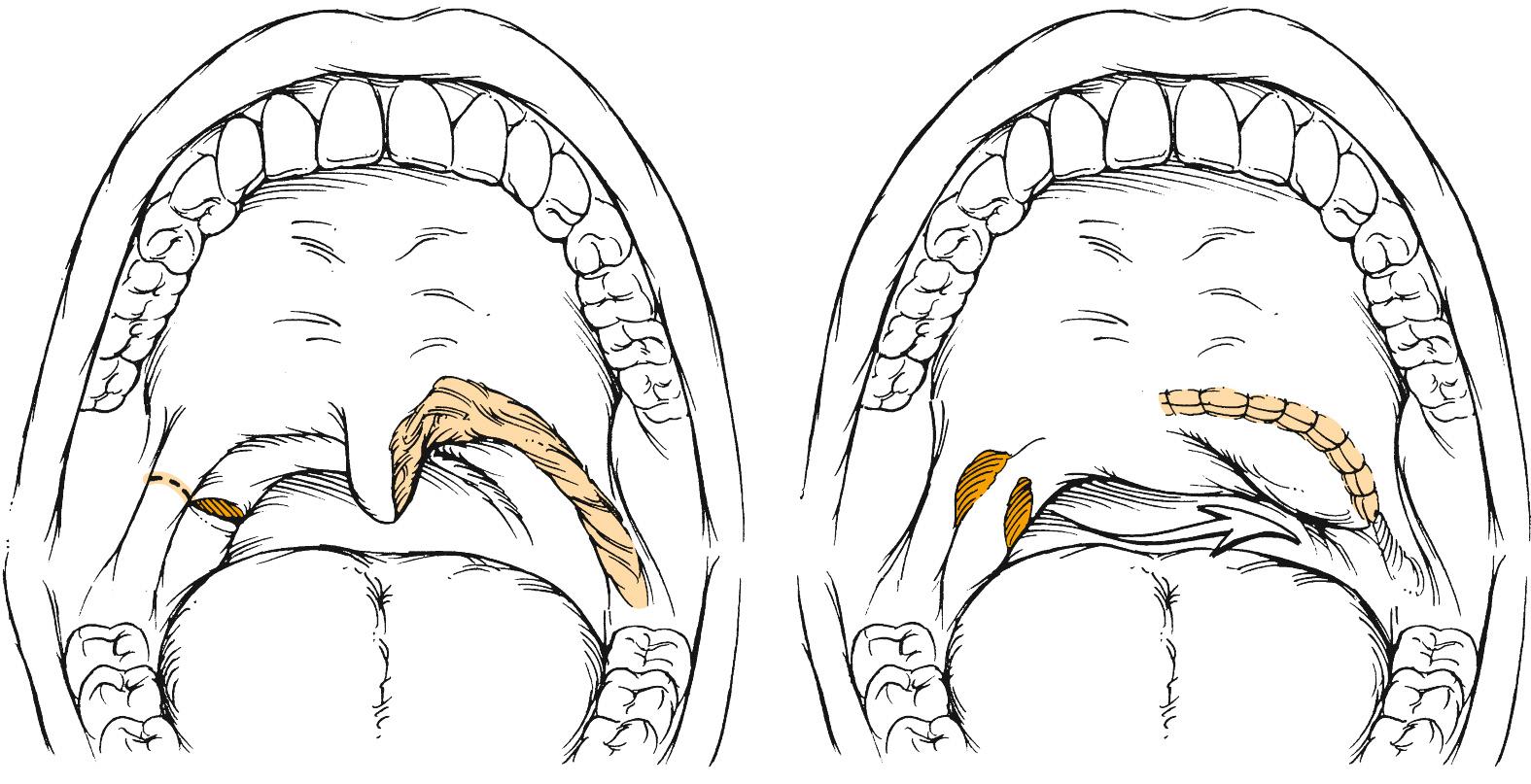
Tongue flaps have limited utility in the oropharynx and are mentioned here only to be discouraged. There are several potential variations, but most require a second stage procedure and have the potential to restrict the mobility of the remaining tongue when used for oropharyngeal reconstruction.
Before the advent of free tissue transfer, oropharyngeal reconstruction was most commonly performed with regional flaps. These flaps remain an excellent option for selected defects of the oropharynx because they are reliable and relatively easy to harvest. The pectoralis major flap has served as the workhorse of head and neck reconstruction for four decades ( Fig. 98.5 ). The flap is based on the thoracoacromial artery, which originates from the second part of the axillary artery. It passes medial to the pectoralis minor and courses on the undersurface of the pectoralis major muscle. The lateral thoracic artery may contribute to the blood supply of the flap as well. The flap can be used as a myocutaneous or a myofascial transfer.
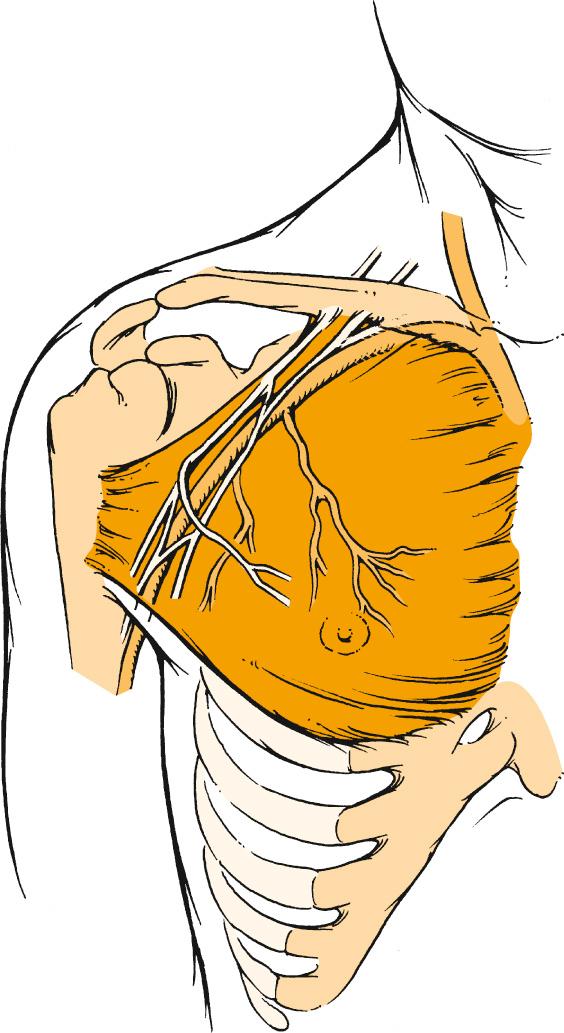
The flap is simple to harvest, and many surgeons prefer to do this through a deltopectoral-sparing incision that starts in the axilla and courses along the lateral border of the muscle inferiorly. If a cutaneous paddle is to be included, the lateral component is first incised, and then the correct planning of the skin paddle over the distal muscle is confirmed. An avascular plane exists between the pectoralis major and the underlying pectoralis minor. The muscle is divided medially and laterally from its sternal and humeral attachments, respectively, after completing incision of the skin paddle, which may then be sutured to the underlying muscle to prevent shearing on the musculocutaneous perforators. The pedicle is identified medial and anterior to the pectoralis minor, and the flap can be narrowed superiorly, or it can be completely skeletonized on the pedicle alone as the clavicle is approached. This assists tunneling into the neck.
The bulk of the flap can make it difficult to fold into a complex oropharyngeal defect; therefore this flap is not the technique of choice for primary reconstructions at most centers. The pectoralis major flap is extremely useful in the salvage of failed reconstructions or in the setting of multiple previous operations, previous radiation/chemoradiation, and persistent pharyngocutaneous leaks.
The supraclavicular flap is a thin, pliable, fasciocutaneous flap based on the supraclavicular artery that can be used for oropharyngeal reconstruction. Kazanjian and Converse described a random flap that incorporated the tissue overlying the shoulder in 1949, but this flap and ensuing modifications were controversial because of high rates of partial loss, which usually affected the distal aspect of the flap. Use of the supraclavicular flap has become more prevalent since Pallua and colleagues’ description of harvest with an axial blood supply in 1997 and subsequent report of its use in head and neck reconstruction as a tunneled island flap. Recent studies have demonstrated that the supraclavicular artery reliably branches off of the transverse cervical system in a triangle formed by the clavicle, the posterior aspect of the sternocleidomastoid muscle, and the external jugular vein ( Fig. 98.6 ). The paddle can reach dimensions of up to 12 supraclavicular artery reliably branches off of the transverse. The donor site is usually closed primarily ( Fig. 98.7 ).
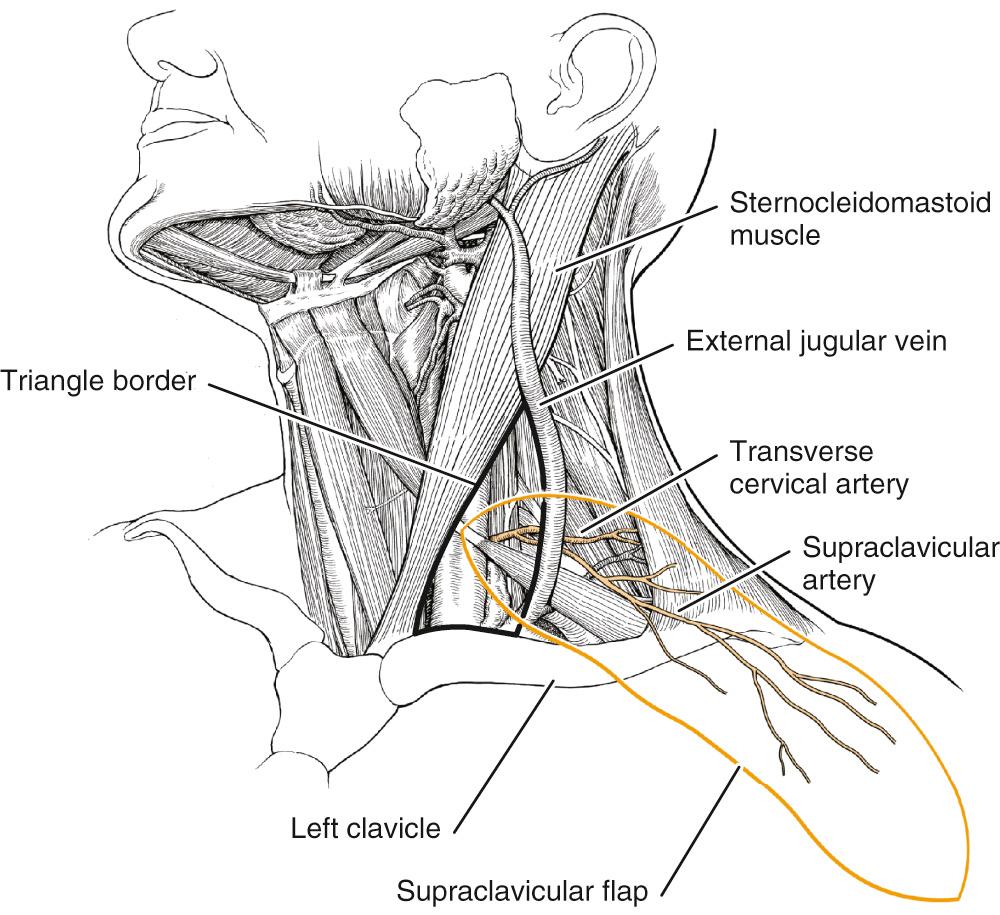

The thin, pliable nature of this flap can make it an attractive option for defects of the lateral pharyngeal wall, soft palate, or partial tongue base. In the setting of a concurrent neck dissection, the donor-site incision can be connected to the posteroinferior portion of a modified apron incision to simplify tunneling of the flap. Several larger series have reported clinical outcomes that support the use of the supraclavicular flap in the head and neck with rates of partial flap loss between 8% to 14% and rates of complete flap loss of 0% to 4%. Only a small proportion of flaps within these series were used to reconstruct oropharyngeal defects; however, two smaller series that reported the use of this flap specifically in the oropharynx displayed similar failure rates. Potential advantages to the supraclavicular flap are the relatively rapid harvest, which has been reported as less than 1 hour, and minimal donor-site morbidity. A potential relative contraindication in oropharyngeal reconstruction occurs when the inset requires significant folding of the distal paddle, which may further compromise the blood supply of this already vulnerable aspect of the flap.
Another increasing utilized regional flap for oropharyngeal reconstruction is the submental island flap. First described by Martin et al. in 1993, the flap can be harvested as a fasciocutaneous, a myocutaneous, or even an osteocutaneous flap. As a fasciocutaneous or myocutaneous flap it offers a regional alternative to a radial forearm or anterolateral thigh (ALT) free flaps.
Several features of the submental island flap have led to its recent popularity. The submental island flap provides a thin pliable tissue paddle with a reliable blood supply, is accessible during oropharyngeal resections, and can be harvested with minimal morbidity. The donor site can be closed primarily, and the scar is well hidden by the projection of the mandibular arch. Of note, most series have reported occasional wound dehiscence or hypertrophic scarring. These complications tend to occur more frequently when the donor site is closed under significant tension.
The flap is generally designed as an ellipse with the superior incision approximately 1 cm inferior to the inferior margin of the mandible to allow concealment of the resulting scar. The cutaneous paddle can reach dimensions of up to 7 cm wide by 18 cm long ( Fig. 98.8 ). Sizing the paddle is done via a pinch test to assess the redundancy of the submental skin and determine the amount that can be resected while still allowing for primary closure.

The submental artery is 1 to 2 mm in diameter and branches off of the facial artery deep to the submandibular gland. It courses anteriorly and travels between the anterior belly of the digastric and the mylohyoid. Branches perfusing the submental skin can be found on both of the medial and lateral borders of the anterior digastric. The submental vein drains into either the facial vein, the external jugular vein, or into both systems. The flap can be harvested by identifying the facial artery proximally, and then dissecting it and the submental vein free from the surrounding tissue. Alternatively, the submental artery can be identified overlying the mylohyoid and be dissected in a retrograde fashion to its source. The mylohyoid and ipsilateral anterior belly of digastric can be partially incorporated with the overlying platysma to protect the perforating branches.
The maximal pedicle length is approximately 8 cm via an anterograde flow pattern from the facial artery to the submental artery (see Fig. 98.8 ). This can be extended by ligating and dividing the facial artery proximal to the takeoff of the submental artery and thereby designing the flap based on retrograde flow from the facial artery to the submental artery.
One potential disadvantage is that it is difficult to have two teams work in parallel, as access to the site by a second team is usually limited during the primary surgery. This drawback is likely completely mitigated by the decreased harvest time and absence of microvascular time. Paydarfar et al. retrospectively reviewed outcomes comparing patients reconstructed with submental island flaps with those who had undergone radial forearm free flaps. While there were limitations with respect to comparability between groups, the analysis revealed a significant decrease in operative time associated with reconstructions using the submental island flap.
The submental branch of the facial artery is also the basis for the platysma myocutaneous flap, which was initially proposed for oropharyngeal reconstruction in 1978. The flap has not gained wide acceptance, and some believe it is an underused technique for head and neck reconstruction. It provides a thin, pliable skin paddle ideal for oropharyngeal reconstruction ( Fig. 98.9 ). The flap can be harvested in 20 to 30 minutes and can be done with or without a neck dissection. The flap is designed low in the neck, with the skin paddle planned over the midportion of the platysma muscle. The upper skin paddle incision is made first, and a subcutaneous flap is raised to the level of the mandible. Next, the inferior portion of the skin paddle is incised and is carried through the platysma. A subplatysmal flap is then elevated to the level of the mandible, which essentially frees the muscle and the overlying skin paddle. Ligation of the facial artery during neck dissection does not compromise the blood supply to the flap. Szudek and Taylor reviewed the use of this flap in head and neck defects using a meta-analysis and reported on 190 cases in the literature ; of these, 20 underwent reconstruction of tonsil or pharyngeal wall defects, and 37 underwent reconstruction of the tongue or of tongue-base defects. Partial skin loss occurred in 25% of these cases, but flap-related complications severe enough to require revision surgery occurred in only 5%. We have previously used this flap with success at our center, but have found the submental island and supraclavicular flaps to be more reliable alternatives.
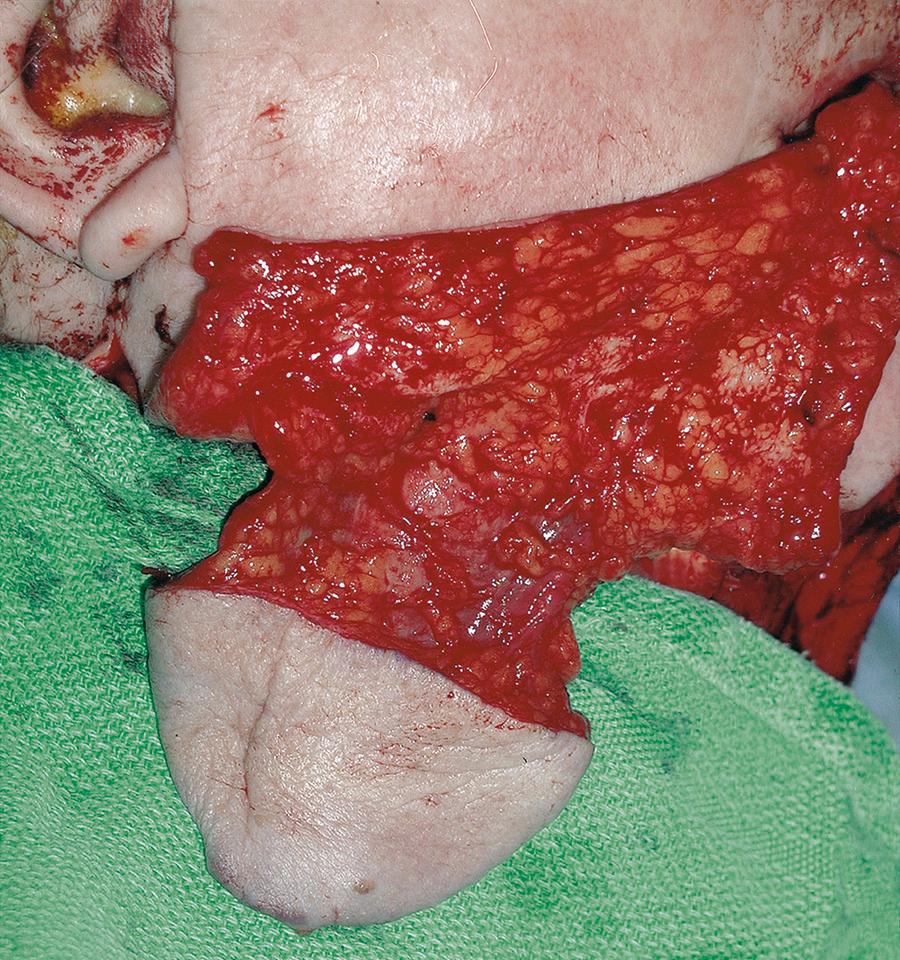
The temporoparietal fascia flap and temporalis flap are two potential regional flaps for oropharyngeal reconstruction harvested from the temporal area. The temporoparietal fascial flap provides thin, highly vascular tissue for reconstruction. Its blood supply is based on the superficial temporal artery and vein, and it can be used either as a pedicled or free tissue transfer, if this is required to enhance inset of the flap. An outer table calvarial bone graft superior to the temporal line may also be harvested with the flap. Identification of the vascular pedicle by Doppler ultrasonography is done at the initiation of the harvest. A preauricular incision is then made that is carried superiorly through the temporal scalp and can be extended to or above the vertex if necessary ( Fig. 98.10 ). The dissection is begun superiorly just deep to the hair follicles. Care must be taken when dissecting the anterior branch of the artery because this is accompanied by the frontal branch of the facial nerve. The fascia is then divided by carrying the dissection to the level of the superficial layer of the deep temporal fascia. It is then narrowed inferiorly; at this point, the anterior branch of the artery is divided close to the origin of the posterior branch of the superficial temporal artery, being aware of the facial nerve. The flap is then tunneled into the oropharynx and is sutured into the defect. A skin graft may be used on the flap but is not necessary because the surface of the flap will remucosalize. Similarly, the temporalis muscle can be tunneled into the oropharynx after removal of the zygomatic arch, which is later replaced. It is less commonly used than the temporoparietal flap because of its added bulk, limited arc of rotation, and difficult tunneling into the defect, although it is a potential option in the repair of soft palate and pharyngeal wall defects.

The latissimus dorsi musculocutaneous flap is another viable option in the reconstruction of oropharyngeal defects. It can be used either as a pedicled or free flap, and provides a large amount of bulky tissue. In the oropharynx, it is most appropriate for total glossectomy defects. The flap is based on the thoracodorsal artery, which is a branch of the subscapular system of vessels. The subscapular artery arises from the third part of the axillary artery. The latissimus muscle arises from the thoracolumbar fascia, the lower six thoracic vertebrae, and the iliac crest, and inserts onto the medial surface of the humerus. Several musculocutaneous perforators supply the overlying skin and are more abundant in the upper two-thirds of the muscle. The flap is harvested by first incising the lateral aspect of the skin paddle and then extending this superiorly, following the lateral border of the muscle into an axillary crease. The pedicle is found along the lateral border of the muscle 8 to 10 cm from the midpoint of the axilla. The medial skin paddle incision is fashioned next, and tacking sutures are placed between the skin and underlying muscle. The muscle is then divided distally and medially, and the pedicle is traced into the axilla after identifying and dividing the branch to the serratus anterior. Finally, the superior muscle cut is made, protecting the vascular pedicle. As a pedicled transfer, it is helpful to preserve the circumflex scapular pedicle to prevent torsion of the thoracodorsal artery. In addition, after the flap is tunneled between the pectoralis major and minor muscles, the humeral tendon can be sutured to a rib to ensure appropriate pedicle geometry.
The longus colli muscle flap can be used to reconstruct defects of the lateral and posterior pharyngeal wall. The flap is reported to have minimal, if any, donor-site complications; however, three patients had postoperative Horner syndrome, and some question remains as to whether this was related to the ablation of high pharyngeal wall tumors as opposed to a flap-related problem.
Become a Clinical Tree membership for Full access and enjoy Unlimited articles
If you are a member. Log in here